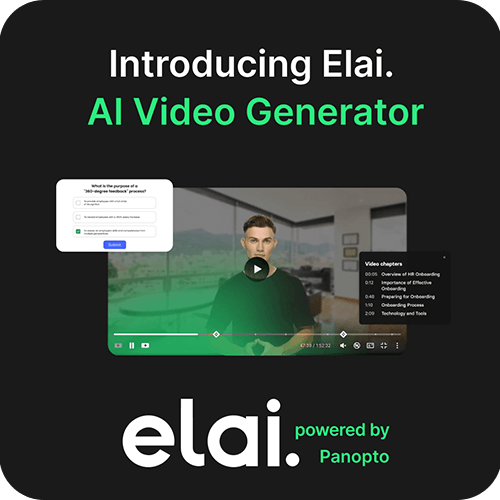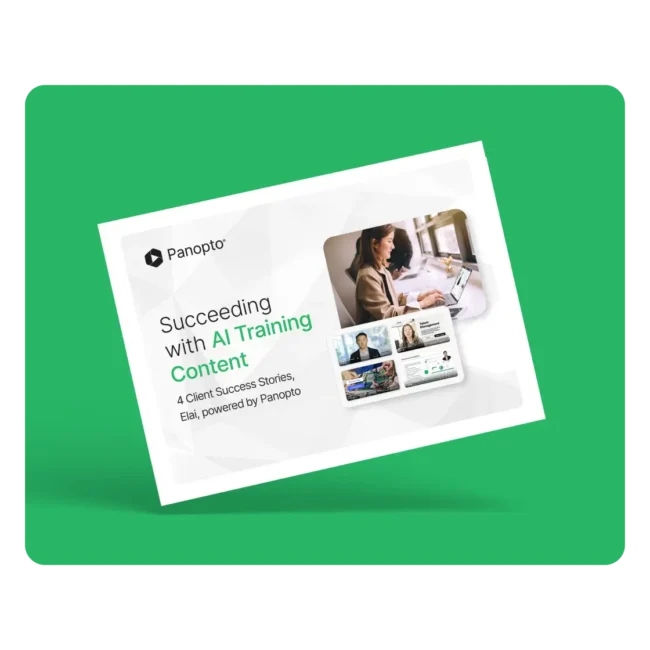- 高等教育
学習におけるさまざまなタイプのAIの理解

人工知能(AI)は、私たちのビジネスのやり方、 そして学習方法を変革しています。 大学のキャンパスから従業員のトレーニングまで、AIの力は、運用、学習モデルなど全体で改善の機会を提供します。
AIとは?
AIは、コンピューターや機械が人間の学習、問題解決、意思決定、創造性を模倣できるようにするテクノロジーの一種です。 反復的なタスクの自動化、データからのより多くの迅速な洞察の収集、意思決定の強化、人為的エラーの排除など、業界全体でいくつかのメリットがあります。
Here’s a look at how three types of AI power successful outcomes for the workforce and higher education.
学習における生成AI
ジェネレーティブAIは学習でどのように使用されますか?
ジェネレーティブAIとは、音声、コード、画像、テキスト、動画など、新しいコンテンツを作成できる人工知能技術です。 これにより、学習者は膨大な量の情報にすぐにアクセスでき、さまざまな言語の背景やアクセシビリティのニーズを持つ学習者を支援し、探求と創造性を加速できます。
学習のためのジェネレーティブAIの3つの利点。
パーソナル化
ジェネレーティブAIアルゴリズムは、学習者の独自の好みや要件に基づいて、特定の動画や記事など、カスタマイズされた教育コンテンツを生成できます。
評価の自動化
たとえば、高等教育では、一部のインストラクターはジェネレーティブAIツールを使用して、コースワークに関する学生に即座にフィードバックを提供しています。
適応学習
コンピューターアルゴリズムとAIは、学習者の固有のニーズに対応するために、カスタマイズされたリソースと学習活動を生成できます。 たとえば、新入社員が使用するソフトウェアプログラムに慣れていない場合、適応型トレーニングでは、より深いトピックに進む前に、ソフトウェアプログラムの使用方法を説明する学習モジュールを推奨する場合があります。
学習における生成AIに関する懸念。
ジェネレーティブAIにはメリットがありますが、課題がないわけではありません。 ツールは、トレーニングされたデータセットに基づいて新しいコンテンツを生成し、それらのデータセットにバイアスが含まれている場合、新しいコンテンツにもバイアスがかかる可能性があります。 ジェネレーティブAIは、ある視点を裏付ける証拠として偽の科学研究を引用するなど、不正確な情報を広めることもあります。 そのため、学生はジェネレーティブAIコンテンツツールに対して懐疑的なままなのでしょう。 最近の Panopto の研究では、正確なコンテンツを生成するために生成 AI を信頼している学生は半数未満です。 Forbesの調査によると、学生の41%がAIが生成したコンテンツを常に編集していると答え、3%はまったく編集しないと回答しています。
学習における予測AI
予測型AIは学習でどのように活用されていますか?
予測AIは、機械学習を使用して過去のイベントのパターンを特定し、将来のイベントについて予測します。 予測型AIは、学習環境における学習者のデータを迅速に分析し、学習パターンや進捗状況を把握し、次に学習する必要があるトピックを予測することができます。
学習のための予測AIの3つの利点。
Improved outcomes
Predictive analytics can help identify learners who need extra help and provide targeted support, improving their learning outcomes in the long term. For example, all bank employees may need training about a new government regulation affecting financial institutions. Still, one who struggles to answer specific questions might be prompted to take a review course on existing banking regulations to provide them with the necessary background. A college student who keeps rewatching a particular math lecture or asking automated questions about a particular math concept might be prompted to watch or review a lesson about a foundational concept that would help them to understand the new concept better.
計画の強化
インストラクターとトレーナーは、予測分析を使用して、トレーニングプログラムのうまく機能している領域と改善が必要な領域を特定できます。 これらの洞察により、彼らはトレーニングプログラムと指導戦略を改善して、学習者のニーズにより適切に対応することができます。
リソース割り当ての改善
予測型AIは、どの学習者やコホートがより多くのサポートを必要としているかを予測でき、組織や高等教育機関が最も有益なリソースを計画し、配分するのに役立ちます。
学習における予測AIに関する懸念。
予測分析では、組織が学習者に関する多くの情報を収集して保存する必要があるため、データのプライバシーとセキュリティに関する懸念が生じる可能性があります。 高等教育機関や学習プログラムで予測型AIを使用している組織は、データプライバシー法に従い、使用するデータを保護するために堅牢なサイバーセキュリティ対策を採用する必要があります。 また、収集されるデータの種類やプライバシーを保護するために講じられた措置について、学習者とコミュニケーションをとる必要があります。
プライバシーに関する懸念を克服する方法の 1 つは、プライバシーを真剣に考えているベンダーと提携することです。 たとえば、Panopto の 顧客中心の AI プライバシー ポリシー により、組織は AI モデリングと技術開発のためのデータの倫理的使用について一致させることができます。
学習における記述的AI
記述型AIは学習でどのように使用されますか?
記述型AIツールは、録画された講義やビジネスドキュメントなどの非構造化データからメタデータを生成するようにトレーニングされています。 データパターンと関係を明らかにし、それらをさまざまなコンポーネントに分類し、過去のパフォーマンス、傾向、またはその他の関連要因を要約できます。
学習のための記述型AIの3つの利点。
データドリブンなインサイト。 記述型AIツールは、学習者と教材とのインタラクション、完了時間、テスト結果、およびパフォーマンスに関するデータを収集および分析できます。 インストラクターとトレーニングリーダーは、そのデータを使用して学習プログラムの成功を測定し、将来のプログラムについて決定を下すことができます。
ノートを取る
学習者は、動画や講義をすばやく要約し、重要なポイントについてメモを取るのを支援できる記述型AIツールの恩恵を受けることができます。 例えば、 Panoptoの Access AI 製品群は、マウスをクリックするだけで、学習動画のトランスクリプトや要点のまとめ、説明文を自動で提供します。
バーチャルチュータリング
記述型AIを搭載したバーチャルチューターは、従来の教室での指導を補完し、高等教育でリアルタイムのフィードバックとサポートを提供できます。
学習における記述型AIに関する懸念
他の形式のAIと同様に、プライバシーとセキュリティは、記述型AIを使用する高等教育機関や職場にとって依然として懸念事項です。 データセキュリティを維持するためには、厳格なデータプライバシーポリシーとレビューを作成することが重要です。
学習でPanopto AIについて学ぶ
PanoptoのAIを活用した動画学習プラットフォームは、1650+のグローバル教育機関のキャンパス外でのアクセス可能な学習を拡大します。20+言語の文字起こしと字幕、学習者がコンテンツをすばやく見つけるのに役立つAIを活用したキーワード検索、動画コンテンツの翻訳のための自動ワークフローなど、 Panopto 教育に特化した使いやすいプラットフォームで動画学習を拡大します。
最新のブログ
-

- トレーニング
Core Competency Training Guide: Transforming Organizational Expertise into Competitive Advantage
Core competency training empowers organizations to harness their unique strengths and turn them into competitive advantages. This separates market leaders from the pack. By strategically identifying and developing these distinctive organizational capabilities, companies create the foundation for sustainable growth and market differentiation that competitors simply cannot replicate. This guide will walk you through implementing practical…
Core Competency Training Guide: Transforming Organizational Expertise into Competitive Advantage
-

- 新入社員研修
Onboarding Solutions That Drive Engagement
Onboarding solutions set the tone regarding how companies welcome new employees. Modern approaches dramatically boost productivity and retention rates. Yet many organizations still use outdated methods that frustrate and disengage new hires. This gap between expectations and reality creates an opportunity. Smart solutions turn a tedious process into a strategic advantage. New employees need more…
Onboarding Solutions That Drive Engagement
-

- ヘルスケア
ヘルスケア向けeラーニングガイド
E-learning for healthcare has revolutionized medical education. Educators are no longer relying solely on classroom training and printed materials. Healthcare organizations face intense pressure to deliver quality training with limited resources. Now, e-learning offers the perfect solution. It transforms how medical professionals stay current with evolving knowledge and practices that save lives. The strategic implementation…
ヘルスケア向けeラーニングガイド



